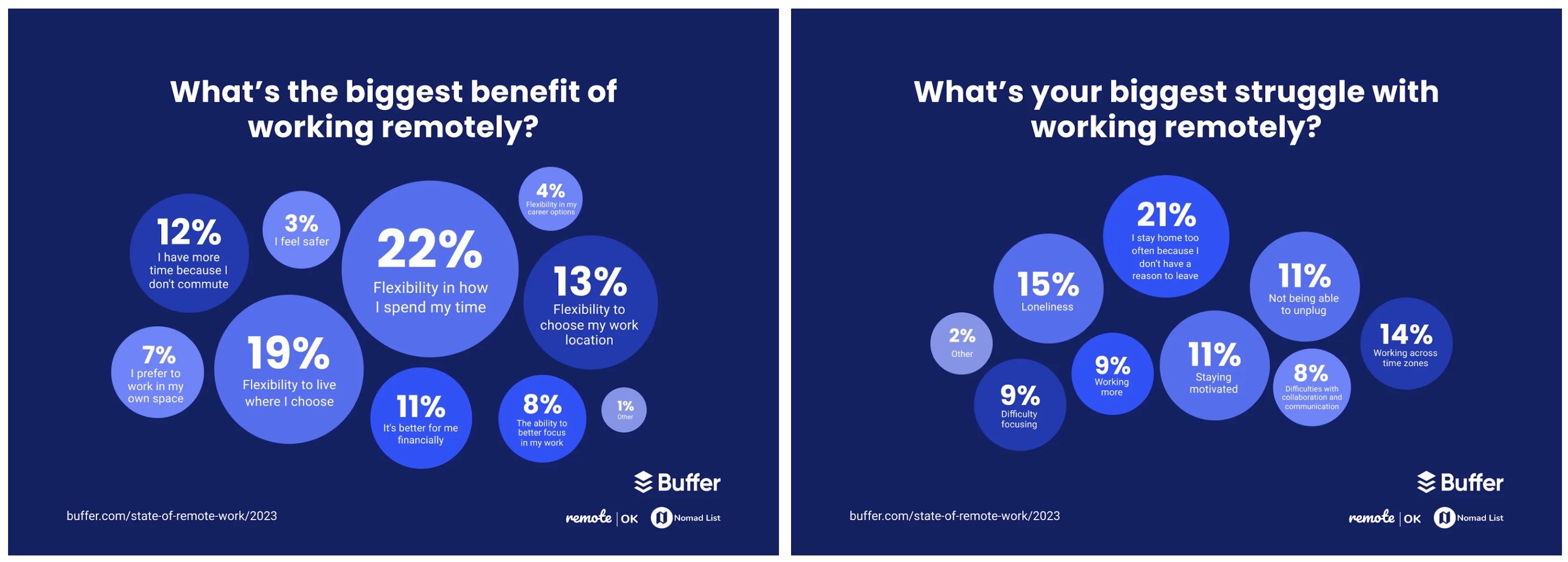Enrapture Immersive Workrooms – Why do we believe in a corporate Metaverse?
A large number of offices today have adopted hybrid-working technology into their working office practices since covid, with video conferencing becoming the norm for most people and offices.
What were the leading video conferencing platforms used in 2020?
- Zoom – 50.3% of respondents
- Microsoft Teams – 12% of respondents
- Facebook Live – 9.4% of respondents
- Instagram Live – 7.3% of respondents
- GoToWebinar – 5.8% of respondents
- YouTube Live – 5.2% of respondents
- On24 – 4.7% of respondents
- WebEx – 1% of respondents
At the onset of the pandemic, Zoom was by far the most used video conferencing platform compared to similar counterparts, like Teams and WebEx. This has led to the rise of the so-called “Zoom fatigue”.

Source: Buffer
Overall, research has shown that for managers to meet employees in the middle it is best 3 days in the office and 2 at home. Yet, employees often prefer to opt for as low as 1-day in the office and the rest at home.
- 80% of people leaders reported that a hybrid setup was exhausting for employees
- 21% of respondents who had quit their jobs in 2021 reported doing so because of a lack of flexible working hours or location
- Office workers went to the office an average of 3.8 days per week pre-pandemic. Post-COVID, this has reduced to an average of 1.4 days per week.
- Just 13% of workers go into the office on a Friday
- The proportion of people who are hybrid working has risen in 2022. 14% worked from home exclusively between 27 April and 8 May 2022, while 24% both worked from home and traveled to work·
Hybrid/Physical Trends
Gen Z is leading the way in the workplace now. Research indicates Gen Z is emerging as the most stressed demographic in the workplace. Similar data shows that unmanageable stress affects almost a quarter of Gen Z respondents (23%), and almost all (98%) are dealing with symptoms of burnout.
While working from home is beginning to be the norm for the workforce, it does cause problems for employers with monitoring, dress codes, and engagement of staff:
- 89% of employees said “absolutely not” to formal dress codes for remote work
- 65% of managers think employees who work from home should dress smarter
- 55% of managers think remote workers should dress more smartly on video calls
- 53% of employees say they dress differently for working in the office versus working at home
- 48% of employers said they were considering a formal dress code for hybrid work
- 42% of employees said having a formal dress code introduced would cause them to look for a new job
While it may be stated that productivity has increased with home working, concerns are growing for the small percentage that finds home working isolating. While one-fifth (20 percent) of employees are burned out at work, half (51 percent) feel more productive when working from home.
A study comparing the data collection features of 32 popular team member monitoring tools discovered:
· 94% track how much time employees spend on tasks
· 75% can take screenshots of workers’ desktops
· 59% collate and report on keyboard and mouse movements
The bottom line is that many workers understand that surveillance tactics are important to the business. They want their employers to be upfront about those measures, especially with the upcoming Gen Alpha. Advocates believe that employers need to establish best practices that respect workers’ privacy, offering stronger assurances about privacy protections and data sharing policies, including limits on storage time
Based on research into the modern office, and using the trends in the workforce of Gen Z and Gen Alpha, the new hybrid office will be somewhat different from today’s office.
Traditional offices usually have a combination of the following characteristics:
- Assigned work areas (cubicles or a private office)
- Partition walls everywhere
- Gloomy colors
- Plain office furniture
- Outdated office decor (picture a painting with a boat on it)
- No recreational or lounge spaces
- Minimal windows and natural light
- A clinical or institutional feel
Businesses are looking to wellness rooms as one piece of the inclusivity puzzle. When it comes to this unique workplace design trend, wellness spaces should be tailored to the health and well-being requirements of your diverse workforce. This can include:
- Nursing rooms
- Prayer rooms
- Resting rooms
As experts in virtual workspaces, we have developed the Enrapture workroom to cater to the specific needs of brands, allowing for customization of design and size. While the core work tools remain unchanged, our virtual environment reduces isolation by promoting socialization and interactivity. This enables companies to customize their workspaces to foster a strong company culture and create the desired atmosphere while ensuring employees feel connected and can strike a healthy balance between work and play through gamification and shared spaces.

The motivation behind building the Enrapture workroom solution MeetWork.Ai stemmed from our expertise gained through successfully running multiple small businesses in virtual worlds. Recognizing the emerging trends in the current workforce (Gen Z) and the upcoming workforce (Gen Alpha), we sought to address the challenges of remote work by providing a comprehensive virtual office solution. This includes essential features such as video conferencing, collaborative sharing boards, file-sharing capabilities, staff monitoring, and artificial intelligence integration.
Enrapture’s AI Workroom solution, MeetWork.ai puts a timely focus on:
1. Advanced Immersivity in work & wellness areas
2. Secure, easily accessible, collaborative layouts
3. Sustainable offices
4. Neurodiverse workspaces
5. Smart offices for work and collaboration
6. Gamified team bonding
7. Most advanced use of Generative AI (Text, Image, 360 Degree Sky, and AI NPC conversations)
8. Transparent employee monitoring practices

However, the true reason behind our virtual office solution extends beyond mere functionality. We acknowledge that modern office design trends align with our understanding of the potential power of virtual worlds. By incorporating well-being spaces that are increasingly sought after in real-world workplaces, we aim to create an immersive virtual experience that can engage groups, classes, teams, or families.
We have become master manipulators in the virtual worlds, from creating landscapes and buildings to customized equipment and full animations to create the optimum experience.

